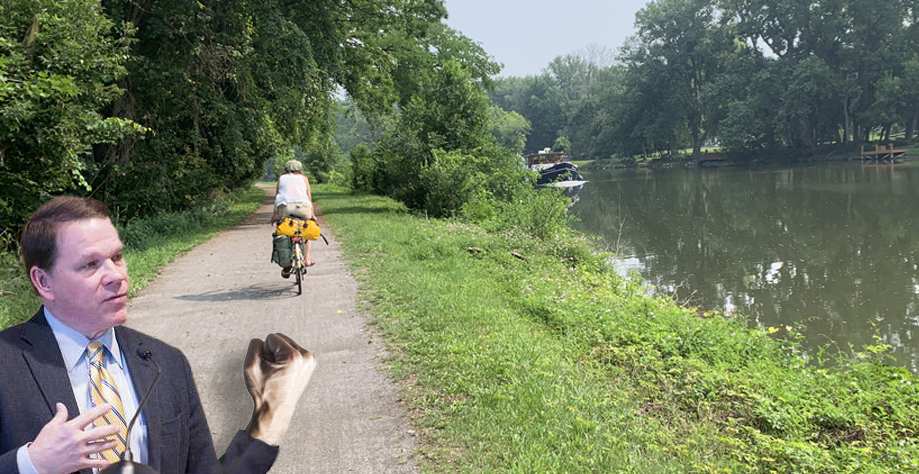The politician in charge of writing the next major federal transportation bill has signaled his intent to zero out funding for walking and biking infrastructure — unless advocates can rally their own representatives to resist him.
Rep. Sam Graves, (R–Mo.), told Punchbowl News that he did not consider infrastructure for biking and walking to be an important federal priority, and that he would not include money for it in the bill intended to replace the Infrastructure Investment and Jobs Act when the latter expires in September 2026 — at least if he were the legislation’s sole author.
Graves is the chair of the House Transportation and Infrastructure Committee, which is responsible for writing most of the lower chamber’s version of the surface transportation reauthorization, colloquially known the “highway bill.” For the last 35 years, though, that legislation has also included funding for multimodal infrastructure, such as bike lanes and walking paths; Graves apparently intends to end that practice.
“It’s going to be a traditional highway bill,” Graves said. “That means building roads and bridges, laying asphalt, pouring concrete. We’re not going to be spending money on murals and train stations or bike paths or walking paths. We’re going to spend money on traditional infrastructure — that’s roads and bridges.”
Advocates are already rallying their members of congress to demand better.
The League of American Bicyclists launched a letter-writing campaign in response to Graves’s comments, slamming the representative for threatening the future of programs like the popular and competitive Reconnecting Communities Grant, which received requests for five times more money than Congress had made available. And advocates are also worried for the future of the Transportation Alternatives Set-Aside program, which received a 60-percent boost to build active transportation infrastructure.
"All of our gains for bicycling and walking are at risk," the League wrote. "If Rep. Graves has his way and the next transportation bill is a 'traditional highway bill,' that could mean zero federal funding for bicycling and walking through 2031."
Graves's comments should alarm anyone who believes in the moral obligation to protect pedestrians and cyclists from escalating rates of traffic violence. His suggestion that bikes lanes do not qualify as "traditional infrastructure," though, is also simply inaccurate.
America owes its first paved roads to the efforts of the League of American Wheelmen — later re-named the League of American Bicyclists — which advocated for asphalt for bicyclists as far back as 1892. As automobiles came to dominate those same roads, American cyclists were forced to pivot, aiming their advocacy instead at securing federal money for more protection from drivers.
That fight finally bore real fruit in 1991, when Congress authorized the creation of the Transportation Enhancements program, which was later renamed as the Transportation Alternatives Set-Aside. Today, walking and biking receive just a fraction of our federal infrastructure dollars — the League estimates an average of just $3.75 per person annually — but communities still rely on that money to complement local dollars to build life-saving projects.
After 35 years of the federal government creating safe routes for people outside cars, though, Graves argued that it's time for biking and walking to take a backseat to a theoretical future packed with driverless cars and trucks.
"Government does two things very well: nothing, and overreact[ing]," the representative said. "One thing that government doesn't do well is anticipate or contemplate. I want to put a highway bill together that addresses the next 20 years of of issues within the transportation system, rather than over reacting to the last 10 years. ... We've already got driverless trucks, driverless cars, driverless airplanes. That technology is gonna explode. We have to anticipate where that technology is taking us and put together a bill that addresses it."
What Graves analysis misses, though, is that ever-increasing automobility isn't a fait accompli; it's the product of policy decisions made largely by lawmakers like him, who could choose otherwise.
His comments are particularly jarring given his concern about the fiscal health of the rapidly dwindling Highway Trust Fund. Taxpayers have been forced to bail it out for the past 17 years, whether or not they drive.
"We're not going to be able to pay for our roads and bridges, and if you're using those roads and bridges, you should be paying into that process," Graves said. "That is the bottom line ... no free rides." The only freeloaders Graves identified were the drivers of electric vehicles, which were a negligible presence on U.S. roads in 2008, when the so-called "user pays" principle of the Highway Trust Fund died its quiet death.
At the Punchbowl event, the chairman repeatedly flogged the need for an EV user fee, which he proposed should be set at around $250 and $100 for hybrids. At a May hearing before Graves's committee, though, Jeff Davis of the Eno Center for Transportation testified that those amounts "wouldn't come close to actually closing the amount of revenue that you need to get another five-year [surface transportation reauthorization] bill."
If Graves is serious about stabilizing America's infrastructure and balancing its pocketbook, he and his peers should spend less on highways and more on alternative modes that get Americans where they need to go — especially across the short distances so many of them are forced to travel by car because it's unsafe to go anywhere outside of one. And if he's serious about funding "traditional infrastructure," he should support modes that predate the automobile, and stop encouraging the private AV-dominated future we can and should avoid.






